
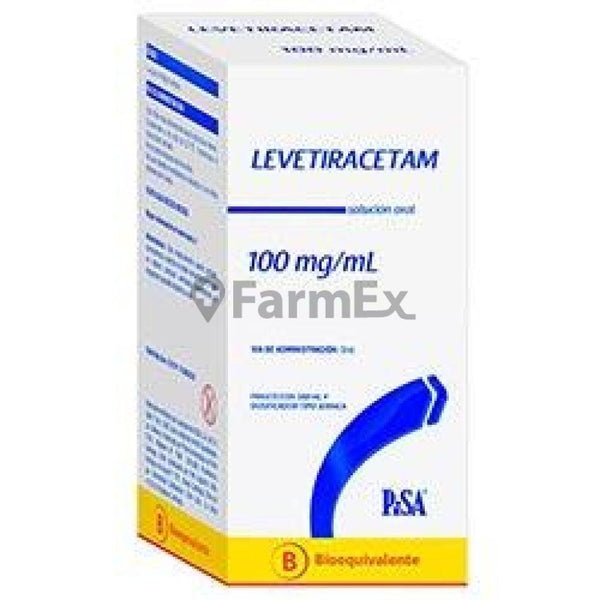
ЛЕВЕТИРАЦЕТАМ ТАРБИС ФАРМА 100 МГ/МЛ ОРАЛЬНЫЙ РАСТВОР

Спросите врача о рецепте на ЛЕВЕТИРАЦЕТАМ ТАРБИС ФАРМА 100 МГ/МЛ ОРАЛЬНЫЙ РАСТВОР

Инструкция по применению ЛЕВЕТИРАЦЕТАМ ТАРБИС ФАРМА 100 МГ/МЛ ОРАЛЬНЫЙ РАСТВОР
Введение
Проспект: информация для пациента
Леветирацетам Тарбис Фарма 100 мг/мл раствор для приема внутрь ЕФГ
леветирацетам
Прочитайте внимательно весь проспект перед началом приема этого лекарства, поскольку он содержит важную информацию для вас.
- Сохраните этот проспект, поскольку вам может потребоваться прочитать его снова.
- Если у вас есть какие-либо сомнения, проконсультируйтесь с вашим врачом или фармацевтом.
- Это лекарство было назначено только вам, и его не следует давать другим людям, даже если у них такие же симптомы, как у вас, поскольку оно может нанести им вред.
- Если вы испытываете побочные эффекты, проконсультируйтесь с вашим врачом или фармацевтом, даже если это побочные эффекты, которые не указаны в этом проспекте. См. раздел 4.
Содержание проспекта
- Что такое Леветирацетам Тарбис Фарма и для чего он используется
- Что вам нужно знать перед началом приема Леветирацетама Тарбис Фарма
- Как принимать Леветирацетам Тарбис Фарма
- Возможные побочные эффекты
- Хранение Леветирацетама Тарбис Фарма
- Содержание упаковки и дополнительная информация
1. Что такое Леветирацетам Тарбис Фарма и для чего он используется
Леветирацетам является противоэпилептическим препаратом (лекарством для лечения приступов при эпилепсии).
Это лекарство используется:
- в качестве монотерапии у взрослых и подростков в возрасте 16 лет и старше с недавно диагностированной эпилепсией для лечения одной формы эпилепсии. Эпилепсия - это заболевание, при котором пациенты испытывают приступы (приступы). Леветирацетам используется для лечения формы эпилепсии, при которой приступы изначально поражают только одну сторону мозга, но могут затем распространиться на более обширные области в обоих полушариях мозга (приступы парциального начала с или без вторичной генерализации). Ваш врач назначил леветирацетам, чтобы уменьшить количество приступов.
- в комбинации с другими противоэпилептическими препаратами для лечения:
- приступов парциального начала с или без генерализации у взрослых, подростков, детей и младенцев старше 1 месяца.
- миоклонических приступов (коротких, типа шока, сакадиров мышц или группы мышц) у взрослых и подростков старше 12 лет с ювенильной миоклонической эпилепсией.
- тонико-клонических генерализованных приступов (больших приступов, включая потерю сознания) у взрослых и подростков старше 12 лет с идиопатической генерализованной эпилепсией (тип эпилепсии, который, как полагают, имеет генетическую причину).
2. Что вам нужно знать перед началом приема Леветирацетама Тарбис Фарма
Не принимайте Леветирацетам Тарбис Фарма
- Если вы аллергичны к леветирацетаму, производным пиролидона или любому другому компоненту этого лекарства (перечисленному в разделе 6).
Предостережения и меры предосторожности
Проконсультируйтесь с вашим врачом перед началом приема этого лекарства
- Если у вас есть проблемы с почками, следуйте инструкциям вашего врача, который решит, следует ли корректировать дозу.
- Если вы заметите любое снижение роста вашего ребенка или неожиданное развитие полового созревания, свяжитесь с вашим врачом.
- Небольшое количество людей, получающих лечение противоэпилептическими препаратами, такими как леветирацетам, имели мысли о причинении вреда себе или суициде. Если у вас есть какие-либо симптомы депрессии и/или мысли о суициде, свяжитесь с вашим врачом.
- Если у вас есть медицинские или семейные анамнезы нерегулярного сердечного ритма (видимого на электрокардиограмме) или если у вас есть заболевание и/или вы получаете лечение, которое делает вас склонным к сердечным аритмиям или нарушениям баланса электролитов.
Сообщите вашему врачу или фармацевту, если любой из следующих побочных эффектов ухудшается или длится более нескольких дней:
- Аномальные мысли, чувство раздражительности или реакция более агрессивно, чем обычно, или если вы или ваша семья и друзья заметили значительные изменения в вашем настроении или поведении.
- Ухудшение эпилепсии
В редких случаях приступы могут ухудшиться или стать более частыми, в основном в течение первого месяца после начала лечения или увеличения дозы. Если вы испытываете любой из этих новых симптомов во время приема этого лекарства, обратитесь к врачу как можно скорее.
Если вы испытываете любой из этих новых симптомов во время приема этого лекарства, обратитесь к врачу как можно скорее.
Дети и подростки
- Монотерапия Леветирацетамом Тарбис Фарма не показана у детей и подростков младше 16 лет.
Другие лекарства и Леветирацетам Тарбис Фарма
Сообщите вашему врачу или фармацевту, если вы принимаете, недавно принимали или можете принять любое другое лекарство.
Не принимайте макрогол (лекарство, используемое как слабительное) в течение часа до и часа после приема леветирацетама, поскольку это может уменьшить его эффект.
Беременность и лактация
Если вы беременны или кормите грудью, считаете, что можете быть беременной или планируете стать беременной, проконсультируйтесь с вашим врачом перед приемом этого лекарства. Леветирацетам можно использовать во время беременности только после тщательной оценки и если ваш врач считает это необходимым.
Не прекращайте лечение без предварительной консультации с вашим врачом.
Нельзя полностью исключить риск врожденных дефектов у ребенка.
Грудное вскармливание не рекомендуется во время лечения.
Вождение и использование машин
Леветирацетам может повлиять на вашу способность управлять транспортными средствами или работать с инструментами или машинами, поскольку он может вызывать сонливость. Это более вероятно в начале лечения или при увеличении дозы. Вы не должны управлять транспортными средствами или работать с машинами, пока не будете уверены, что ваша способность выполнять эти действия не нарушена.
Леветирацетам Тарбис Фарма содержит метилпараоксибензоат (Е218), пропилпараоксибензоат (Е216) и мальтитол (Е965).
Метилпараоксибензоат (Е218) и пропилпараоксибензоат (Е216) могут вызывать аллергические реакции.
Мальтитол: если ваш врач сообщил вам, что у вас есть непереносимость некоторых сахаров, проконсультируйтесь с вашим врачом перед приемом этого лекарства.
Это лекарство содержит менее 23 мг натрия (1 ммоль) на мл; это означает, что оно практически не содержит натрия.
3. Как принимать Леветирацетам Тарбис Фарма
Следуйте точно инструкциям по приему этого лекарства, указанным вашим врачом или фармацевтом. В случае сомнений проконсультируйтесь с вашим врачом или фармацевтом.
Леветирацетам следует принимать дважды в день, утром и вечером, примерно в одно и то же время каждый день.
Принимайте раствор для приема внутрь согласно инструкциям вашего врача.
Монотерапия (с 16 лет)
Взрослые (≥18 лет) и подростки (с 16 лет):
Для пациентов старше 4 лет измерьте необходимую дозу с помощью шприца на 10 мл, включенного в упаковку.
Рекомендуемая доза: леветирацетам принимается дважды в день, в двух равных дозах, каждая доза составляет от 5 мл (500 мг) до 15 мл (1500 мг).
Когда вы начинаете принимать Леветирацетам, ваш врач назначит более низкую дозу в течение двух недель, прежде чем назначить минимальную суточную дозу.
Сочетанная терапия
Доза для взрослых и подростков (от 12 до 17 лет):
Для пациентов старше 4 лет измерьте необходимую дозу с помощью шприца на 10 мл, включенного в упаковку.
Рекомендуемая доза: Леветирацетам принимается дважды в день, в двух равных дозах, каждая доза составляет от 5 мл (500 мг) до 15 мл (1500 мг).
Доза для детей старше 6 месяцев:
Ваш врач назначит наиболее подходящую лекарственную форму леветирацетама в зависимости от возраста, веса и дозы.
Для детей от 6 месяцев до 4 лет, измерьте необходимую дозу с помощью шприца на 3 мл, включенного в упаковку.
Для детей старше 4 лет, измерьте необходимую дозу с помощью шприца на 10 мл, включенного в упаковку.
Рекомендуемая доза: Леветирацетам принимается дважды в день, в двух равных дозах, каждая доза составляет от 0,1 мл (10 мг) до 0,3 мл (30 мг) на килограмм веса ребенка (см. примеры доз в следующей таблице).
Доза для детей старше 6 месяцев:
Вес | Начальная доза: 0,1 мл/кг дважды в день | Максимальная доза: 0,3 мл/кг дважды в день |
6 кг | 0,6 мл дважды в день | 1,8 мл дважды в день |
8 кг | 0,8 мл дважды в день | 2,4 мл дважды в день |
10 кг | 1 мл дважды в день | 3 мл дважды в день |
15 кг | 1,5 мл дважды в день | 4,5 мл дважды в день |
20 кг | 2 мл дважды в день | 6 мл дважды в день |
25 кг | 2,5 мл дважды в день | 7,5 мл дважды в день |
От 50 кг | 5 мл дважды в день | 15 мл дважды в день |
Дозировка для младенцев (от 1 месяца до менее 6 месяцев):
Для младенцев от 1 месяца до менее 6 месяцев, измерьте необходимую дозу с помощью шприца на 1 мл, включенного в упаковку.
Рекомендуемая доза: Леветирацетам принимается дважды в день, в двух равных дозах, каждая доза составляет от 0,07 мл (7 мг) до 0,21 мл (21 мг) на килограмм веса младенца (см. примеры доз в следующей таблице).
Доза для младенцев (от 1 месяца до менее 6 месяцев):
Вес | Начальная доза: 0,07 мл/кг дважды в день | Максимальная доза: 0,21 мл/кг дважды в день |
4 кг | 0,3 мл дважды в день | 0,85 мл дважды в день |
5 кг | 0,35 мл дважды в день | 1,05 мл дважды в день |
6 кг | 0,45 мл дважды в день | 1,25 мл дважды в день |
7 кг | 0,5 мл дважды в день | 1,5 мл дважды в день |
Способ введения:
Это лекарство предназначено для приема внутрь. После измерения необходимой дозы с помощью соответствующего шприца раствор для приема внутрь Леветирацетама можно разбавить в стакане воды или в бутылке. Леветирацетам можно принимать с или без пищи. После перорального приема леветирацетама может ощущаться горький вкус.
Инструкции по использованию шприца:
- Открыть флакон: нажать на крышку и повернуть против часовой стрелки (рисунок 1)

- Следуйте этим шагам в первый раз, когда принимаете Леветирацетам:
- Удалите адаптер из шприца для приема внутрь (рисунок 2).
- Вставьте адаптер в верхнюю часть флакона (рисунок 3). Убедитесь, что он правильно установлен. Не нужно удалять адаптер после использования.

- Следуйте этим шагам каждый раз, когда принимаете Леветирацетам
- Вставьте шприц для приема внутрь в отверстие адаптера (рисунок 4).
- Переверните флакон вверх дном (рисунок 5).

- Держите флакон вверх дном одной рукой, а другой рукой наполните шприц для приема внутрь.
- Потяните за поршень вниз, чтобы наполнить шприц для приема внутрь небольшым количеством раствора (рисунок 5А).
- Затем нажмите на поршень вверх, чтобы удалить возможные пузырьки воздуха (рисунок 5Б).
- Потяните за поршень вниз до отметки дозы в миллилитрах (мл), указанной на шприце для приема внутрь и назначенной вашим врачом (рисунок 5В). Поршень может отойти в цилиндре при первой дозе, поэтому убедитесь, что вы держите поршень на месте до тех пор, пока не отсоедините шприц от флакона.
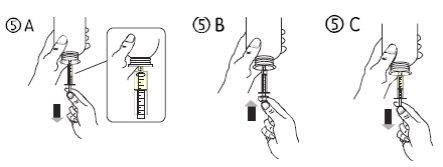
- Поставьте флакон вверх тормашками (рисунок 6А). Удалите шприц из адаптера (рисунок 6Б).
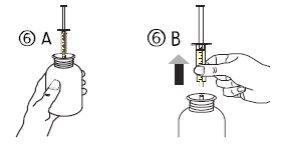
- Выпустите содержимое шприца в стакан воды или в бутылку, опустив поршень до конца шприца (рисунок 7).
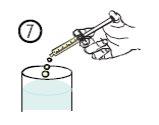
- Выпейте содержимое стакана или бутылки полностью.
- Закройте флакон крышкой с резиновой пробкой (не нужно удалять адаптер).
- Чтобы очистить шприц, промойте его только холодной водой, перемещая поршень несколько раз вверх и вниз, чтобы впитать и выпустить воду, не разделяя два компонента (рисунок 8).
- Храните флакон, шприц для приема внутрь и проспект в упаковке.
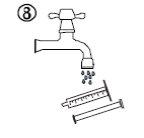
Продолжительность лечения:
- Леветирацетам используется как длительное лечение. Вы должны продолжать лечение леветирацетамом в течение времени, указанного вашим врачом.
- Не прекращайте лечение без рекомендации вашего врача, поскольку это может увеличить количество приступов.
Если вы приняли больше Леветирацетама Тарбис Фарма, чем следует
Возможные побочные эффекты передозировки леветирацетама - сонливость, агитация, агрессивность, снижение бдительности,抑ение дыхания и кома.
Свяжитесь с вашим врачом, если вы приняли больше раствора для приема внутрь, чем следует. Ваш врач определит лучшее возможное лечение передозировки.
В случае передозировки или случайного приема проконсультируйтесь с вашим врачом или фармацевтом или позвоните в Центр токсикологической информации, телефон 915 620 420, указав лекарство и количество, использованное.
Если вы пропустили прием Леветирацетама Тарбис Фарма:
Свяжитесь с вашим врачом, если вы пропустили одну или несколько доз.
Не принимайте двойную дозу, чтобы компенсировать пропущенные дозы.
Если вы прекратили лечение Леветирацетамом Тарбис Фарма:
Прекращение лечения леветирацетамом должно осуществляться постепенно, чтобы избежать увеличения количества приступов. Если ваш врач решит прекратить ваше лечение леветирацетамом, он/она даст вам инструкции по постепенному прекращению приема леветирацетама.
Если у вас есть какие-либо другие вопросы о использовании этого лекарства, проконсультируйтесь с вашим врачом или фармацевтом.
4. Возможные побочные эффекты
Как и все лекарства, леветирацетам может вызывать побочные эффекты, хотя не все люди их испытывают.
Сообщите своему врачу немедленно, или обратитесь в приемное отделение ближайшей больницы, если вы испытываете:
- слабость, головокружение или трудности с дыханием, поскольку они могут быть признаками тяжелой аллергической реакции (анафилактической)
- отек лица, губ, языка или горла (отек Квинке)
- симптомы гриппа и высыпания на лице, за которыми следует длительная высыпание с повышенной температурой, повышенными уровнями печеночных ферментов в анализах крови и увеличением количества определенного типа белых кровяных клеток (эозинофилия) и увеличением лимфатических узлов и поражением других органов тела (реакция гиперчувствительности к лекарству с эозинофилией и системными симптомами (DRESS))
- симптомы, такие как низкий объем мочи, усталость, тошнота, рвота, спутанность сознания и отек ног, рук или ног, поскольку они могут быть признаком внезапного снижения функции почек
- высыпание на коже, которое может образовывать пузыри и может выглядеть как небольшие мишени (центральные темные точки, окруженные более светлой областью, с темным кольцом вокруг края) (эритема многоформная)
- общее высыпание с пузырями и шелушением кожи, особенно вокруг рта, носа, глаз и гениталий (синдром Стивенса-Джонсона)
- более тяжелая форма, вызывающая шелушение кожи на более чем 30% поверхности тела (токсический эпидермальный некролиз)
- признаки тяжелых изменений психики или если кто-то вокруг вас заметит признаки спутанности сознания, сонливости (заторможенности), амнезии (потери памяти), ухудшения памяти (забывчивости), аномального поведения или других неврологических симптомов, включая непроизвольные или неконтролируемые движения. Эти симптомы могут быть признаками энцефалопатии.
Наиболее часто сообщаемые побочные эффекты - ринофарингит, сонливость (чувство сна), головная боль, усталость и головокружение. Побочные эффекты, такие как чувство сна, чувство слабости и головокружение, могут быть более частыми при начале лечения или увеличении дозы. Однако эти побочные эффекты должны уменьшаться со временем.
Очень часто:могут встречаться более чем у 1 из 10 человек
- ринофарингит;
- сонливость (чувство сна), головная боль.
Часто:могут встречаться до 1 из 10 человек
- анорексия (потеря аппетита);
- депрессия, враждебность или агрессивность, тревога, бессонница, нервозность или раздражительность;
- припадки, нарушение равновесия, головокружение (чувство нестабильности), вялость (отсутствие энергии и энтузиазма), тремор (непроизвольный тремор);
- вертиго (чувство вращения);
- кашель;
- боль в животе, диарея, диспепсия (тяжелое пищеварение, изжога и кислотность), рвота, тошнота;
- высыпание на коже;
- астения/усталость (чувство слабости).
Не часто:могут встречаться до 1 из 100 человек
- снижение количества тромбоцитов, снижение количества белых кровяных клеток;
- потеря веса, набор веса;
- попытка самоубийства и мысли о самоубийстве, психические расстройства, аномальное поведение, галлюцинации, гнев, спутанность сознания, паническая атака, эмоциональная нестабильность/изменения настроения, агитация;
- амнезия (потеря памяти), ухудшение памяти (потеря памяти), нарушение координации/атаксия (нарушение координации движений), парестезия (ползание), нарушение внимания (потеря концентрации);
- диплопия (двойное зрение), размытое зрение;
- повышенные/анормальные значения в анализах функции печени;
- потеря волос, экзема, зуд;
- слабость мышц, миалгия (боль в мышцах);
- травма.
Редко:могут встречаться до 1 из 1000 человек
- инфекция;
- снижение всех типов кровяных клеток;
- тяжелые аллергические реакции (DRESS, анафилактическая реакция (тяжелая и серьезная аллергическая реакция), отек Квинке (отек лица, губ, языка и горла));
- снижение концентрации натрия в крови;
- самоубийство, расстройства личности (проблемы поведения), аномальное мышление (медленное мышление, трудности с концентрацией);
- делирий;
- энцефалопатия (см. подраздел «Сообщите своему врачу немедленно» для подробного описания симптомов);
- припадки могут ухудшаться или возникать чаще;
- неконтролируемые мышечные спазмы, поражающие голову, туловище и конечности, трудности с контролем движений, гиперкинезия (гиперактивность);
- изменение сердечного ритма (электрокардиограмма);
- панкреатит (воспаление поджелудочной железы);
- почечная недостаточность, гепатит (воспаление печени);
- внезапное снижение функции почек;
- высыпание на коже, которое может привести к образованию пузырей, которые могут выглядеть как небольшие мишени (центральные темные точки, окруженные более светлой областью, с темным кольцом вокруг края) (эритема многоформная), общее высыпание с пузырями и шелушением кожи, особенно вокруг рта, носа, глаз и гениталий (синдром Стивенса-Джонсона) и более тяжелая форма, вызывающая шелушение кожи на более чем 30% поверхности тела (токсический эпидермальный некролиз);
- рабдомиолиз (разрушение мышечной ткани) и повышение креатинфосфокиназы в крови. Распространенность значительно выше у японских пациентов по сравнению с неяпонскими пациентами;
- хромота или трудности с ходьбой.
- комбинация лихорадки, мышечной жесткости, нестабильного артериального давления и частоты сердечных сокращений, спутанности сознания, состояния низкого уровня сознания (могут быть признаками синдрома, называемого злокачественным нейролептическим синдромом). Распространенность значительно выше у японских пациентов по сравнению с неяпонскими пациентами.
Сообщение о побочных эффектах
Если вы испытываете любой побочный эффект, проконсультируйтесь с вашим врачом или фармацевтом, даже если это возможные побочные эффекты, которые не указаны в этом листке. Также можно сообщить напрямую через веб-сайт Sistema Español de Farmacovigilancia de Medicamentos de Uso Humano: www.notificaRAM.es. Сообщая о побочных эффектах, вы можете внести свой вклад в предоставление более подробной информации о безопасности этого лекарства.
5. Хранение Леветирацетама Тарбис Фарма
Храните это лекарство в недоступном для детей месте.
Не используйте это лекарство после даты истечения срока годности, указанной на картоне после CAD. Дата истечения срока годности - последний день месяца, указанного.
Это лекарство не требует специальных условий хранения.
Лекарства не должны выбрасываться в канализацию или в мусор. Поместите упаковку и лекарства, которые вам больше не нужны, в пункт SIGRE аптеки. В случае сомнений спросите у вашего фармацевта, как избавиться от упаковки и лекарств, которые вам больше не нужны. Таким образом, вы поможете защитить окружающую среду.
6. Содержание упаковки и дополнительная информация
Состав Леветирацетама Тарбис Фарма
Активное вещество - леветирацетам.
Каждый мл содержит 100 мг леветирацетама.
Другие компоненты - жидкий мальтитол (E965), глицерин (E422), метилпараоксibenzoат (E218), пропилпараоксibenzoат (E216), цитрат натрия моногидрат, лимонная кислота (дигидрат), аммониевый глицирризинат, ацесульфам калия (E950), ароматизатор винограда, очищенная вода
Внешний вид продукта и содержание упаковки
Леветирацетам Тарбис Фарма 100 мг/мл пероральная растворимая форма - прозрачная бесцветная жидкость.
Размеры упаковки:
Флакон из коричневого стекла объемом 300 мл (тип III) (содержащий 300 мл пероральной растворимой формы) с белой крышкой, защищенной от детей (полиэтилен), вместе с градуированной оральной дозировкой 10 мл (полипропилен) и адаптером для дозировки (полиэтилен), все это в картонной коробке.
Флакон из коричневого стекла объемом 200 мл (тип III) (содержащий 150 мл пероральной растворимой формы) с белой крышкой, защищенной от детей (полиэтилен), вместе с градуированной оральной дозировкой 3 мл (полипропилен) и адаптером для дозировки (полиэтилен), все это в картонной коробке.
Флакон из коричневого стекла объемом 200 мл (тип III) (содержащий 150 мл пероральной растворимой формы) с белой крышкой, защищенной от детей (полиэтилен), вместе с градуированной оральной дозировкой 1 мл (полипропилен) и адаптером для дозировки (полиэтилен), все это в картонной коробке.
Возможно, не все размеры упаковки будут продаваться.
Владелец разрешения на маркетинг
Тарбис Фарма С.Л.
Гран Вия Карлос III, 94
08028 Барселона
Испания
Производитель
Амарокс Фарма Б.В.
Роубослаан 32
Ворсхотен, 2252TR
Нидерланды
Это лекарство разрешено к продаже в государствах-членах Европейского экономического пространства под следующими названиями:
Нидерланды: Леветирацетам Амарокс 100 мг/мл раствор для приема внутрь
Германия: Леветирацетам Амарокс 100 мг/мл пероральная растворимая форма
Испания: Леветирацетам Тарбис Фарма 100 мг/мл пероральная растворимая форма ЕФГ
Дата последнего пересмотра этого листка:Март 2024
Подробная информация о этом лекарстве доступна на сайте Агентства по лекарствам и медицинским изделиям Испании (AEMPS) http://www.aemps.gob.es/

Сколько стоит ЛЕВЕТИРАЦЕТАМ ТАРБИС ФАРМА 100 МГ/МЛ ОРАЛЬНЫЙ РАСТВОР в Испании в 2025 году?
Средняя цена на ЛЕВЕТИРАЦЕТАМ ТАРБИС ФАРМА 100 МГ/МЛ ОРАЛЬНЫЙ РАСТВОР в декабрь, 2025 года составляет около 28.32 евро. Финальная стоимость может зависеть от региона, конкретной аптеки и рецептурного статуса. Для точной информации лучше проверить онлайн или в ближайшей аптеке.
- Страна регистрации
- Средняя цена в аптеках28.32 EUR
- Активное вещество
- Требуется рецептДа
- Производитель
- Информация носит справочный характер и не является медицинской рекомендацией. Перед приемом любых препаратов проконсультируйтесь с врачом. Oladoctor не несет ответственности за медицинские решения, принятые на основе этого контента.
- Аналоги ЛЕВЕТИРАЦЕТАМ ТАРБИС ФАРМА 100 МГ/МЛ ОРАЛЬНЫЙ РАСТВОРФорма выпуска: ИНЪЕКЦИОННЫЙ РАСТВОР ДЛЯ ИНФУЗИЙ, 100 мгАктивное вещество: ЛеветирацетамПроизводитель: Ucb PharmaТребуется рецептФорма выпуска: ИНЪЕКЦИОННЫЙ РАСТВОР ДЛЯ ИНФУЗИЙ, 100 мг/млАктивное вещество: ЛеветирацетамПроизводитель: Ucb PharmaТребуется рецептФорма выпуска: ОРАЛЬНЫЙ РАСТВОР/СУСПЕНЗИЯ, 100 мгАктивное вещество: ЛеветирацетамПроизводитель: Ucb PharmaТребуется рецепт
Аналоги ЛЕВЕТИРАЦЕТАМ ТАРБИС ФАРМА 100 МГ/МЛ ОРАЛЬНЫЙ РАСТВОР в других странах
Лучшие аналоги с тем же действующим веществом и терапевтическим эффектом.
Аналог ЛЕВЕТИРАЦЕТАМ ТАРБИС ФАРМА 100 МГ/МЛ ОРАЛЬНЫЙ РАСТВОР в Polonia
Аналог ЛЕВЕТИРАЦЕТАМ ТАРБИС ФАРМА 100 МГ/МЛ ОРАЛЬНЫЙ РАСТВОР в Ucrania
Врачи онлайн по ЛЕВЕТИРАЦЕТАМ ТАРБИС ФАРМА 100 МГ/МЛ ОРАЛЬНЫЙ РАСТВОР
Консультация по дозировке, побочным эффектам, взаимодействиям, противопоказаниям и продлению рецепта на ЛЕВЕТИРАЦЕТАМ ТАРБИС ФАРМА 100 МГ/МЛ ОРАЛЬНЫЙ РАСТВОР – по решению врача и с учетом местных правил.







